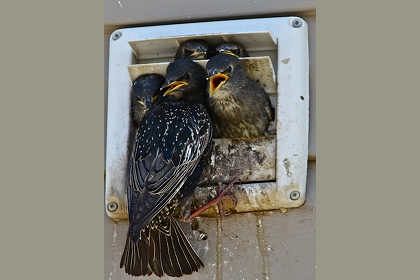
Starling Identification
The European Starling was first discovered in Tennessee in 1921, originating from the descendants of 100 birds that were initially released in New York's Central Park during the 1890s. These robust blackbirds boast lustrous feathers that can emit a greenish tint when exposed to sunlight. Additionally, during the winter, their feathers develop white tips, creating a spotted appearance. Starlings are distinguished by their elongated, pointed bills, and they tend to walk rather than hop. As for their dietary preferences, these birds have a varied diet that includes invertebrates, fruits, and seeds.

Problems and Damage
Starlings can cause significant issues with their droppings and crop damage. They are also known to infiltrate buildings and residences for nesting purposes. A common issue with Starling infestations occurs when they build nests in the exhaust vents of homes. Typically, Starlings will construct nests and rear their young in the flexible ducts connected to bathrooms or dryers. Additionally, they can also bring bird-related insects into your home.

Prevention and Exclusions
In order to prevent starlings from infiltrating your residence, Freedom Trappers can pinpoint and seal off any possible entryways using durable materials capable of preventing Starlings from re-entering your home.

Starling Removal
If you've encountered a starling infestation in your home, Freedom Trappers provides expert bird removal services. Our Wildlife Specialists are well-versed in starling behavior, and through the use of our bird one-way systems, we can promptly and compassionately eliminate the presence of these birds.


 Back
Back